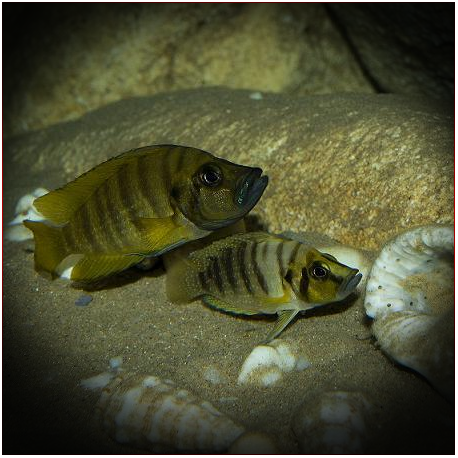More info
Datasheet
| Minimum Tank Size | 250 litres / 66.04 US gallons |
| Maximum Size | 12.5cm / 4.92inches |
| Temperature | 24°C / 75.20°F - 28°C / 82.40°F |
| Hardness | 7.00dgH / 125ppm - 25.04dgH / 447ppm |
| pH | 8.0-9.0 |
Behaviour
Best maintained as a single pair, the Compressiceps can also thrive in groups in larger aquarium setups. Not particularly territorial, it can be a good addition to a well-chosen Tanganyikan community but should not be kept with species small enough to be considered food. It is not a suitable companion for Tropheus or any fish requiring a low-protein diet.
Feeding and Diet
Being a specialized carnivore, the Compressiceps feeds mainly on invertebrates, crustaceans, and smaller fish in its natural habitat. While captive specimens can adapt to dried foods, they thrive better on live or frozen options like bloodworms, Tubifex, Artemia, prawns, and earthworms. Feeder fish such as livebearers are not recommended due to their low nutritional value and potential disease transmission risks.
Reproduction & Dimorphism
The Compressiceps is a substrate spawner, with the female typically laying eggs in crevices among rocks. After fertilization, the female guards the eggs until they hatch, which usually takes 3-5 days. The fry become free-swimming and ready to accept food like Artemia nauplii. Sexual dimorphism is evident as males grow considerably larger than females and develop slightly extended fins as they mature.
Habitat and Distribution
Endemic to Lake Tanganyika, the Compressiceps is distributed widely across various locations around the lake characterized by rocky substrate with ample cover of biofilm. While mainly found in deeper waters, juveniles can be seen in shallower areas. Lake Tanganyika, known for its diverse cichlid population, has around 250 described endemic species that exhibit remarkable morphological and ecological diversity.
Aquarium Setup
To recreate its natural habitat, provide the Compressiceps with a sandy substrate and complex rock structures that occupy most of the tank space. Rocks should be placed directly on the tank base to prevent toppling. Maintaining high water quality is crucial, necessitating regular water changes of up to 50%.
General Description
The Compressiceps, scientifically known as Altolamprologus Compressiceps, showcases varied color patterns depending on its locality. Endemic to Lake Tanganyika, this species can be found in multiple variants, each requiring separate maintenance to prevent hybridization. It belongs to the family Cichlidae and typically grows up to 12.5 cm in size.

